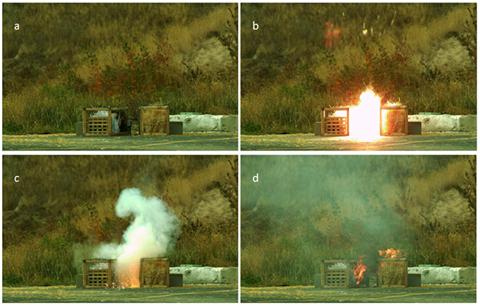The U.S. Forest Service has banned the use of exploding targets1 on land managed in much of the western U.S. because of reported association with wildfire ignitions2. Exploding targets are composed of two ingredients: ammonium nitrate (AN) and aluminum powder (AL). When mixed, the AN oxidizer reacts with the AL fuel to detonate following a high velocity impact. The targets are intended to be detonated by rifle bullets. Numerous media reports and abundant online video suggest ignition from exploding targets is possible, but manufacturers maintain that exploding targets cannot start fires.
A project was begun to formally address two questions:
1) Can exploding targets be demonstrated to cause ignition, and then, if so,
2) What are the factors that contribute to the ignitions?
Tests conducted in 2014 involved shooting ten targets with various configurations of combustible material located adjacent to the target. Combustible material was enclosed in rectangular wooden cages wrapped in plastic deer fence. Straw bales were also used. Two cages were placed on either side of the target and the target was detonated by shooting it from 70 yards with a rifle bullet. High speed video captured the explosion and allowed qualitative analysis of factors related to ignitions.
Three of the ten tests were observed to produce rapid flaming ignition of the nearby fuel materials. The factor suspected to cause ignition was burning powdered aluminum ejected from the explosion, which could clearly be seen in the high speed video. Residual burning of aluminum was observed on the pedestal holding the target (see photo, bottom left). These results are preliminary but suggest the avenues of further study should involve effects of varying AN/AL mixtures and detonation as they relate to ignition.
